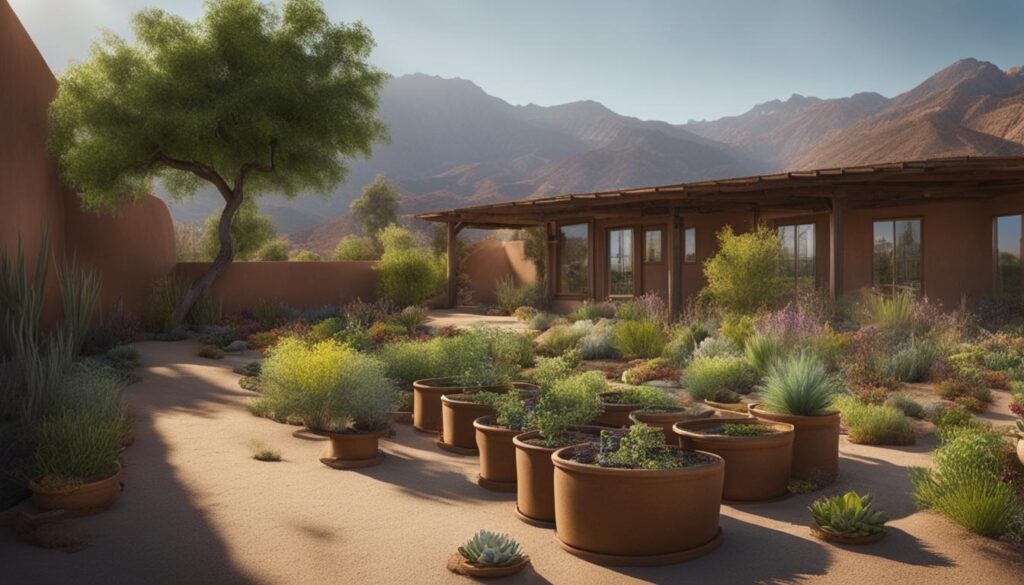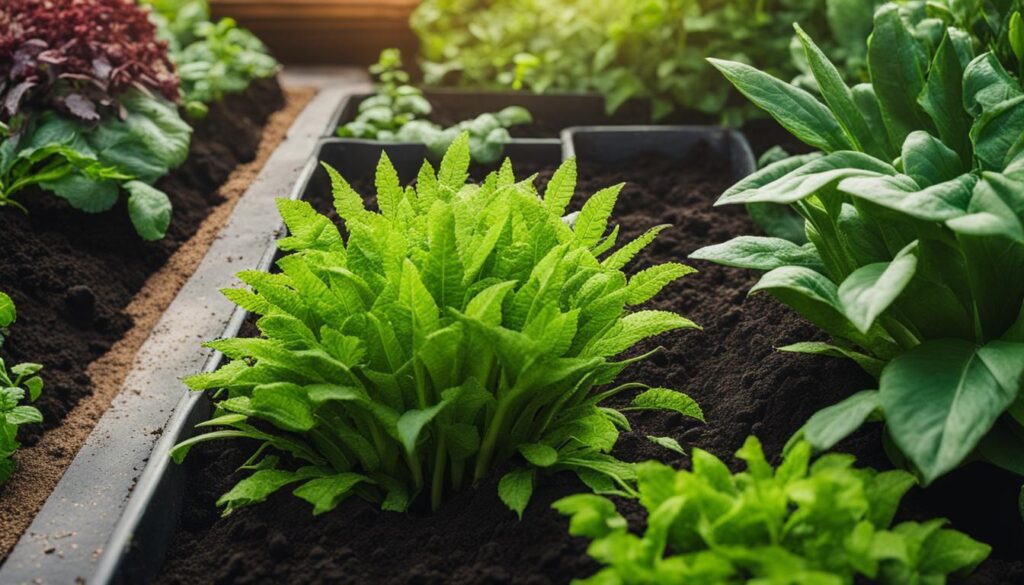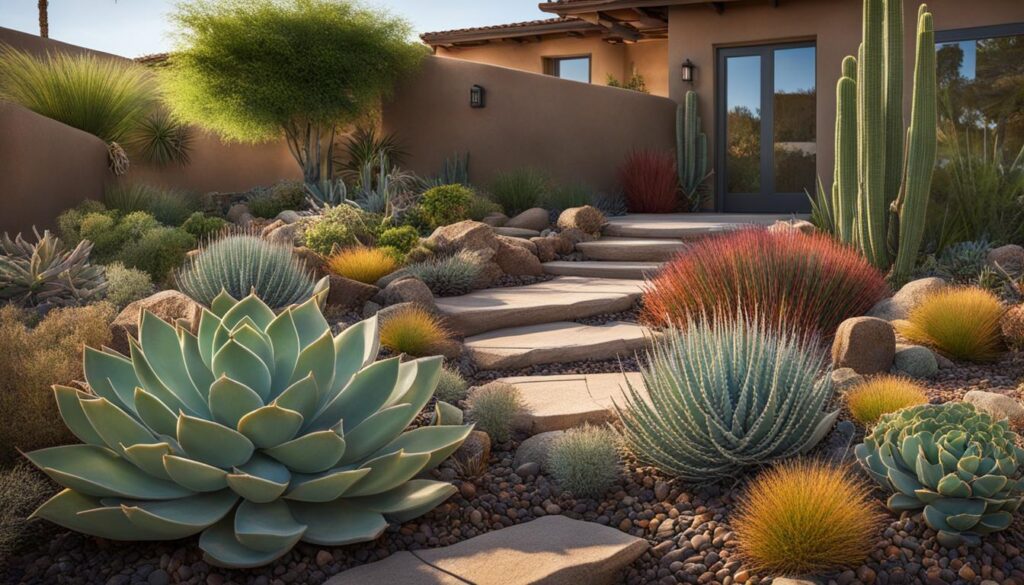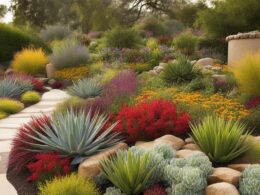Welcome to our comprehensive guide on unlocking soil moisture retention in xeriscapes. If you’re interested in water-saving gardening techniques and creating lush landscapes in dry areas, then this guide is for you. Xeriscaping goes beyond just planting drought-tolerant plants. It involves proper plant selection, improving the soil, mulching, and efficient watering techniques. By implementing these principles, you can save water, conserve resources, and maintain a beautiful landscape.
Key Takeaways:
- By practicing xeriscaping principles, you can reduce water usage by 50-75% and create landscapes that require little maintenance.
- Proper plant selection and grouping based on light, water, and soil requirements is crucial for xeriscapes.
- Improving the soil with compost and moisture control garden soil enhances water retention and plant growth.
- Add a 3-inch layer of high-quality mulch to control weeds, moderate soil temperature, and retain moisture.
- Water efficiently with drip irrigation or soaker hose, promoting deep root growth and withstanding hot and dry conditions.
The Principles Behind Xeriscaping
In order to effectively implement xeriscaping techniques, it is important to understand the principles that guide this water-saving gardening approach. By following these principles, you can conserve water, improve soil quality, and create a sustainable and low-maintenance landscape. Here are the key principles of xeriscaping:
- Water Conservation: Xeriscaping emphasizes the efficient use of water by minimizing evaporation and runoff. By using water-wise practices such as drip irrigation and mulching, you can significantly reduce water usage.
- Soil Improvement: Improving the soil quality is crucial for xeriscaping. By adding organic matter such as compost or using specialized moisture control garden soil, you can enhance water retention and provide essential nutrients for plant growth.
- Native Plants: Using native plants in your xeriscape design is important for several reasons. Native plants are adapted to the local climate and require less water and maintenance. They also provide habitat for local wildlife.
- Mulching: Mulch plays a vital role in xeriscaping by reducing evaporation, moderating soil temperature, and suppressing weeds. Applying a layer of organic mulch around plants helps retain soil moisture and improve overall plant health.
- Irrigation: Proper irrigation techniques are essential for water efficiency in xeriscapes. Drip irrigation systems and soaker hoses deliver water directly to the roots, minimizing water loss through evaporation. Watering deeply and infrequently promotes deeper root growth and drought tolerance.
- Maintenance: Low maintenance is one of the key advantages of xeriscaping. By selecting drought-tolerant plants and implementing efficient watering techniques, you can reduce the need for frequent maintenance tasks such as mowing and pruning.
Xeriscaping is a holistic approach that combines these principles to create a beautiful and environmentally friendly landscape. By following these guidelines, you can conserve water, improve soil health, and create a sustainable garden that thrives even in dry conditions.
Table: Comparison of Water Conservation Techniques
| Technique | Water Efficiency | Soil Health | Maintenance |
|---|---|---|---|
| Drip Irrigation | High | Improves soil moisture retention | Low |
| Soaker Hoses | High | Improves soil moisture retention | Low |
| Traditional Sprinklers | Medium | May lead to water runoff | Medium |
| Hand Watering | Low | Depends on watering technique | High |
The table above provides a comparison of different water conservation techniques commonly used in xeriscaping. Drip irrigation and soaker hoses are the most efficient methods, delivering water directly to the roots while minimizing water loss. Traditional sprinklers and hand watering can be less efficient and may require more maintenance.
Select and Group Plants Appropriately
When practicing xeriscaping, it’s crucial to select and group plants in the right location based on their light, water, and soil requirements. By doing so, you can ensure that each plant thrives in its optimal environment, conserving water and promoting healthy growth.
First, consider the light conditions in your landscape. Some plants require full sun, while others prefer partial or full shade. By grouping plants with similar light requirements together, you can maximize their growth potential and minimize water needs.
Next, analyze the water needs of the plants you choose. Drought-tolerant plants, such as succulents and native grasses, are excellent choices for xeriscapes. These plants have adapted to thrive in arid conditions and require minimal watering once established. In contrast, water-loving plants should be grouped separately and located near a water source for efficient irrigation.
Finally, consider the soil type and quality in your garden. Some plants prefer well-drained sandy soil, while others thrive in clay or loam. By grouping plants with similar soil requirements together, you can ensure that they receive the right amount of water and nutrients for optimal growth.
In summary, proper plant selection and grouping are essential for successful xeriscaping. By considering light, water, and soil requirements, you can create a harmonious landscape that conserves water, minimizes maintenance, and promotes the health and beauty of your plants.
Improve the Soil in Your Garden
One key aspect of successful xeriscaping is improving the soil in your garden. By enhancing the soil’s ability to retain water, you can create an environment that promotes optimal plant growth even in dry conditions. There are several methods you can use to improve soil moisture retention.
Compost: A Natural Soil Enhancer
Compost is a valuable resource for improving soil quality and increasing water retention. It enriches the soil with organic matter, which helps improve its structure and ability to retain moisture. By adding compost to your garden, you can enhance the soil’s water-holding capacity and provide essential nutrients to your plants. Consider starting a compost pile or purchasing compost from a local garden center to give your soil a natural boost.
Miracle-Gro Moisture Control Garden Soil
To further enhance moisture retention in your xeriscape garden, you can incorporate Miracle-Gro Moisture Control Garden Soil into your native soil. This product is specially formulated to hold up to 25% more water than native soil, ensuring optimal moisture levels for your plants. By using Miracle-Gro Moisture Control Garden Soil, you can maximize water efficiency and create an ideal growing environment for drought-tolerant plants.
| Soil Improvement Methods | Benefits |
|---|---|
| Adding compost | Enhances soil structure and water-holding capacity |
| Mixing Miracle-Gro Moisture Control Garden Soil into native soil | Increases moisture retention by up to 25% |
By adopting these soil improvement techniques, you can create a garden that retains moisture effectively, reducing the need for frequent watering and ensuring the health and vitality of your plants. Remember, improving soil moisture retention is a crucial step in the xeriscaping process and will contribute to the overall success of your water-saving gardening endeavor.
Add Mulch
Mulching is a key practice in xeriscaping that offers a range of benefits for your garden. By adding a 3-inch layer of high-quality mulch, such as Scotts Nature Scapes Advanced, you can effectively control weeds, moderate soil temperature, and retain soil moisture. This not only promotes the health and growth of your plants but also conserves water in dry areas.
One of the primary benefits of mulching is weed control. The layer of mulch acts as a barrier, preventing weeds from germinating and competing with your plants for water and nutrients. This saves you time and effort in weed management, allowing you to focus on the beauty and health of your garden.
In addition to weed control, mulch helps moderate soil temperature by providing insulation. It keeps the soil cooler in hot summer months and warmer during colder periods, creating a more favorable environment for plant roots. This temperature moderation enhances plant growth and resilience, especially in regions with extreme weather conditions.
Furthermore, mulching promotes soil moisture retention. It acts as a protective layer, reducing water evaporation from the soil surface and minimizing the need for frequent watering. This not only saves water but also ensures that your plants have a consistent supply of moisture for healthy growth. Using organic mulch, such as pine needles, wood chips, or compost, is highly recommended, as it eventually integrates into the soil, adding organic matter and further improving its structure.
| Mulching Benefits | How It Helps |
|---|---|
| Weed Control | Acts as a barrier, preventing weed growth |
| Soil Temperature Moderation | Insulates the soil, keeping it cooler or warmer as needed |
| Soil Moisture Retention | Reduces water evaporation, ensuring consistent moisture for plants |
Use Water Wisely
In xeriscaping, it’s crucial to use water efficiently to ensure the health and sustainability of your landscape. By adopting water-efficient watering practices, you can maximize water conservation and minimize waste. Here are some key techniques to help you use water wisely:
1. Drip Irrigation
Drip irrigation is a highly effective method for delivering water directly to the plant roots, minimizing evaporation and runoff. This system uses a network of tubes and emitters that slowly release water, providing a slow and steady supply to the plants. It is particularly beneficial for xeriscapes as it promotes deep root growth and reduces water loss.
2. Soaker Hose
A soaker hose is another efficient watering option for xeriscapes. This porous hose releases water directly into the soil, ensuring that it reaches the plant roots without wastage. It delivers a slow, steady stream, allowing for deep watering and preventing surface runoff.
3. Deep Watering
Deep watering is essential for developing robust root systems in xeriscapes. By applying water deeply and infrequently, you encourage plants to grow deep roots that can access moisture stored deeper in the soil. Deep watering also helps plants withstand dry periods, as they can tap into these reserves for sustenance.
By implementing water-efficient watering techniques such as drip irrigation, using soaker hoses, and practicing deep watering, you can ensure that your xeriscape receives the right amount of water while minimizing wastage. These methods promote water conservation, maximize plant health, and contribute to the overall sustainability of your landscape.
| Watering Technique | Advantages | Disadvantages |
|---|---|---|
| Drip Irrigation | – Delivers water directly to plant roots – Minimizes evaporation and runoff – Promotes deep root growth |
– Initial installation cost – Requires regular maintenance |
| Soaker Hose | – Releases water directly into the soil – Prevents surface runoff – Provides slow, steady watering |
– May require multiple hoses for larger areas – Prone to clogging if not properly maintained |
| Deep Watering | – Promotes the development of deep root systems – Helps plants withstand dry periods – Reduces water evaporation |
– Requires careful monitoring to avoid overwatering – May take longer to water large areas |
Recommended Products
When it comes to enhancing soil moisture retention in xeriscapes, choosing the right products can make a significant difference. Here are some highly recommended options:
Soil Products
In order to improve the overall quality of your soil and enhance its ability to retain moisture, consider using Miracle-Gro Garden Soil All-Purpose. This product is specifically formulated to provide essential nutrients and promote healthy plant growth. It can be mixed into the native soil or used as a top dressing for existing plants.
Water-Soluble Plant Food
Another key aspect of maintaining a vibrant xeriscape is providing your plants with the nutrients they need. Miracle-Gro Water Soluble All-Purpose Plant Food is an excellent choice for this purpose. It can be easily mixed with water and applied to your plants, ensuring they receive a balanced blend of essential nutrients for optimal growth and water efficiency.
Drought-Tolerant Plants
To further enhance the water-saving capabilities of your xeriscape, incorporating drought-tolerant plants is essential. These plants have evolved to thrive in dry conditions and require minimal water once established. Miracle-Gro Shake ‘N Feed All Purpose Plant Food is specifically designed for drought-tolerant plants, providing them with the nutrients they need to stay healthy and vibrant.
| Product | Description | Benefits |
|---|---|---|
| Miracle-Gro Garden Soil All-Purpose | A specially formulated soil that enhances water retention and provides essential nutrients. | – Improves soil quality – Promotes healthy plant growth – Enhances water efficiency |
| Miracle-Gro Water Soluble All-Purpose Plant Food | A water-soluble plant food that delivers essential nutrients to your plants. | – Balanced blend of nutrients – Enhances plant growth – Maximizes water efficiency |
| Miracle-Gro Shake ‘N Feed All Purpose Plant Food | A specially formulated plant food for drought-tolerant plants. | – Provides nutrients for drought-tolerant plants – Enhances water-saving capabilities – Supports healthy and vibrant growth |
By incorporating these recommended products into your xeriscape, you can ensure optimal soil moisture retention while promoting the health and vitality of your plants.
Drought-Tolerant Plants for Your Landscape and Garden
If you’re looking to create a beautiful and water-efficient garden, incorporating drought-tolerant plants is essential. These plants have adapted to thrive in dry conditions and require minimal water once established. By adding them to your xeric landscape, you can conserve water and maintain a vibrant garden even in areas with water scarcity.
There are various drought-tolerant plants to consider for your landscape. Here are a few popular options:
- Agastache: Also known as hyssop or hummingbird mint, Agastache produces vibrant flowers that attract pollinators. They are drought-tolerant and require minimal water.
- Cacti: Cacti are well-suited for xeric landscapes as they store water in their thick stems and can survive long periods without irrigation.
- Coneflower: Coneflower is a native wildflower that thrives in dry conditions. It’s known for its colorful blooms and ability to attract butterflies.
- Liatris: Liatris, also known as blazing star or gayfeather, features tall spikes of purple flowers. It’s a low-water use plant that adds vertical interest to your garden.
- Ornamental Grasses: Ornamental grasses are versatile and come in various heights, colors, and textures. They require minimal water and can add texture and movement to your landscape.
- Yucca: Yucca is a striking plant that adds architectural interest to your garden. It’s drought-tolerant and requires minimal care once established.
Incorporating these drought-tolerant plants into your xeric landscape not only saves water but also adds beauty and resilience to your garden. They are well-suited for low-water use gardens and can thrive in dry, arid climates.
| Plant | Water Needs | Sun Exposure | Height |
|---|---|---|---|
| Agastache | Low | Full sun | 1-3 ft |
| Cacti | Low | Full sun | Varies |
| Coneflower | Low | Full sun to part shade | 2-5 ft |
| Liatris | Low | Full sun | 2-4 ft |
| Ornamental Grasses | Low | Full sun to part shade | Varies |
| Yucca | Low | Full sun | Varies |
Overall Benefits of Xeriscape Gardening
Xeriscape gardening offers numerous benefits beyond water conservation. By implementing water-saving techniques and sustainable practices, you can create a beautiful and eco-friendly landscape. Here are some of the key advantages of xeriscape gardening:
Water Conservation
Xeriscaping significantly reduces water usage compared to traditional gardening methods. By incorporating drought-tolerant plants, practicing efficient watering techniques, and using mulch to retain soil moisture, you can conserve water resources while still enjoying a lush and thriving garden.
Low Maintenance
Xeriscape gardens require less maintenance compared to traditional landscapes. By carefully selecting plants that are well-suited to the local climate and soil conditions, you can reduce the need for frequent watering, fertilizing, and pruning. This not only saves you time and effort but also reduces the use of potentially harmful chemicals.
Increased Property Value
A well-designed xeriscape garden can increase the value of your property. Buyers are often attracted to homes with beautiful, low-maintenance landscapes that require less water and upkeep. Additionally, xeriscapes can enhance curb appeal, making your property stand out in the neighborhood.
Wildlife Habitat
Xeriscaping creates an inviting habitat for local wildlife. By incorporating native plants that provide food and shelter, you can attract birds, butterflies, and beneficial insects to your garden. This helps promote biodiversity and contributes to the overall health of the ecosystem.
Pollution-Free
Xeriscape gardening reduces pollution and promotes a cleaner environment. By minimizing the use of gas-powered equipment, such as lawnmowers and trimmers, you can significantly reduce air and noise pollution. Additionally, xeriscapes typically require fewer chemical inputs, such as pesticides and herbicides, further minimizing environmental impact.
By embracing xeriscape gardening, you can enjoy these multiple benefits while making a positive impact on the environment and conserving precious water resources.
Xeriscaping: A Sustainable Solution for Soil Moisture Retention
Are you looking for a water-saving gardening technique that can help retain soil moisture in dry areas? Look no further than xeriscaping. By implementing the principles of water conservation, soil improvement, appropriate plant selection, mulching, efficient irrigation, and proper maintenance, xeriscaping offers a sustainable solution to maintain a lush and beautiful landscape while conserving resources.
One of the key aspects of xeriscaping is water conservation. By using water wisely and minimizing evaporation, you can significantly reduce water usage in your garden. Drip irrigation and soaker hoses deliver water directly to the roots, ensuring efficient water distribution. This not only saves water but also promotes deep root growth, enabling plants to withstand hot and dry conditions.
In addition to water conservation, improving the soil is crucial for optimizing soil moisture retention. Adding compost or moisture control garden soil to the native soil allows it to hold water and nutrients more effectively, benefiting plant growth. Organic mulch, such as pine needles or wood chips, also plays a vital role in xeriscaping by controlling weeds, moderating soil temperature, and retaining soil moisture.
A Comparison of Watering Methods
| Watering Method | Advantages | Disadvantages |
|---|---|---|
| Overhead Watering | Easy application | High water loss due to evaporation |
| Drip Irrigation | Efficient water delivery | Requires proper installation and maintenance |
| Soaker Hose | Water directly to the roots | May require longer watering duration |
By understanding and implementing the principles of xeriscaping, you can create a water-saving garden that thrives in even the driest areas. Embrace the beauty of xeriscaping and make a positive impact on the environment while enjoying a vibrant and sustainable landscape.
Are there Different Strategies for Maximizing Soil Moisture in Xeriscapes?
Yes, there are different strategies for maximizing soil moisture in xeriscapes. Implementing soil water storage techniques such as using mulch, planting drought-tolerant plants, and incorporating rainwater harvesting systems can help retain moisture in the soil for longer periods, reducing the need for frequent watering.
Recommended Resources
If you’re looking for more information on xeriscaping, drought-tolerant plants, and water-saving gardening, the following resources can provide valuable insights:
1. “Drought Tolerant Plants & Flowers: Defy the Dry”
Discover a comprehensive guide on selecting and growing drought-tolerant plants and flowers. This resource offers tips and advice on creating a thriving garden in water-scarce areas.
2. “Best Soil to Use in Containers and Raised Beds”
Learn about the ideal soil options for containers and raised beds in your xeriscape garden. This resource provides guidance on choosing the right soil for optimum moisture retention and plant health.
3. “Xeriscaping is a type of landscape design”
Explore the concept of xeriscaping as a sustainable landscape design approach. This resource highlights the key principles and benefits of xeriscaping, helping you create an environmentally friendly and water-efficient garden.
By utilizing these resources, you can enhance your knowledge of xeriscaping techniques, choose the right drought-tolerant plants, and implement water-saving practices to create a beautiful and sustainable garden.














